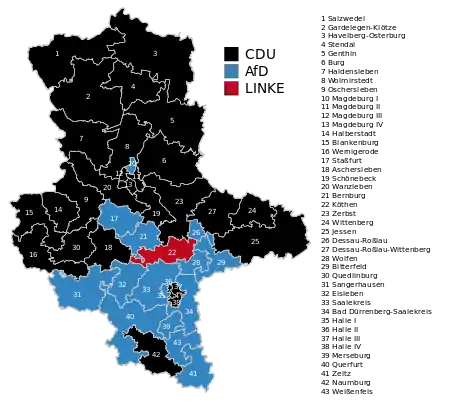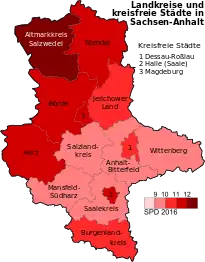2016 Saxony-Anhalt state election
The 2016 Saxony-Anhalt state election was held on 13 March 2016 to elect the members of the 7th Landtag of Saxony-Anhalt. The incumbent grand coalition of the Christian Democratic Union (CDU) and Social Democratic Party (SPD) led by Minister-President Reiner Haseloff lost its majority. The Alternative for Germany (AfD) debuted at 24.3%, with every other parliamentary party recording losses, particularly the SPD and The Left.
| |||||||||||||||||||||||||||||||||||||||||||||||||||||||||||||||||||||||||||||
All 87 seats in the Landtag of Saxony-Anhalt 44 seats needed for a majority | |||||||||||||||||||||||||||||||||||||||||||||||||||||||||||||||||||||||||||||
|---|---|---|---|---|---|---|---|---|---|---|---|---|---|---|---|---|---|---|---|---|---|---|---|---|---|---|---|---|---|---|---|---|---|---|---|---|---|---|---|---|---|---|---|---|---|---|---|---|---|---|---|---|---|---|---|---|---|---|---|---|---|---|---|---|---|---|---|---|---|---|---|---|---|---|---|---|---|
| Turnout | 1,122,877 (61.1%) | ||||||||||||||||||||||||||||||||||||||||||||||||||||||||||||||||||||||||||||
| |||||||||||||||||||||||||||||||||||||||||||||||||||||||||||||||||||||||||||||
 Results for the direct mandates. | |||||||||||||||||||||||||||||||||||||||||||||||||||||||||||||||||||||||||||||
| |||||||||||||||||||||||||||||||||||||||||||||||||||||||||||||||||||||||||||||
The CDU subsequently formed a coalition with the SPD and The Greens, which was dubbed the "Kenya coalition".[1] Haseloff was re-elected as Minister-President on 25 April.[2]
Parties
The table below lists parties represented in the 6th Landtag of Saxony-Anhalt.
| Name | Ideology | Leader(s) | 2011 result | |||
|---|---|---|---|---|---|---|
| Votes (%) | Seats | |||||
| CDU | Christian Democratic Union of Germany Christlich Demokratische Union Deutschlands |
Christian democracy | Reiner Haseloff | 32.5% | 41 / 105 | |
| Linke | The Left Die Linke |
Democratic socialism | Wulf Gallert | 23.7% | 29 / 105 | |
| SPD | Social Democratic Party of Germany Sozialdemokratische Partei Deutschlands |
Social democracy | Katrin Budde | 21.5% | 26 / 105 | |
| Grüne | Alliance 90/The Greens Bündnis 90/Die Grünen |
Green politics | Claudia Dalbert | 7.1% | 9 / 105 | |
Opinion polling
| Polling firm | Fieldwork date | Sample size |
CDU | Linke | SPD | Grüne | FDP | AfD | Others | Lead |
|---|---|---|---|---|---|---|---|---|---|---|
| 2016 state election | 13 Mar 2016 | – | 29.8 | 16.3 | 10.6 | 5.2 | 4.9 | 24.3 | 9.0 | 5.5 |
| Forschungsgruppe Wahlen | 7–10 Mar 2016 | 1,096 | 32 | 21 | 14 | 5 | 4.5 | 18 | 5.5 | 11 |
| Forsa | 2–8 Mar 2016 | 1,001 | 30 | 20 | 17 | 5 | 5 | 18 | 5 | 10 |
| INSA | 1–5 Mar 2016 | 1,000 | 29 | 20 | 15.5 | 6 | 4 | 19 | 6.5 | 9 |
| Forschungsgruppe Wahlen | 29 Feb–3 Mar 2016 | 1,027 | 32 | 20 | 15 | 5 | 4 | 17 | 7 | 12 |
| Infratest dimap | 29 Feb–2 Mar 2016 | 1,001 | 31.0 | 21.0 | 15.0 | 5.5 | 4.5 | 19.0 | 4.0 | 10.0 |
| uniQma | 19–29 Feb 2016 | 1,008 | 30 | 19 | 18 | 5 | 4 | 17 | 7 | 11 |
| INSA | 25–27 Feb 2016 | 1,001 | 29.5 | 20 | 17 | 5 | 5 | 17 | 6.5 | 9.5 |
| INSA | 19–20 Feb 2016 | 1,000 | 30 | 21 | 16 | 5 | 4 | 17 | 7 | 9 |
| Infratest dimap | 10–13 Feb 2016 | 1,001 | 32 | 20 | 18 | 5 | 4 | 17 | 4 | 12 |
| Forschungsgruppe Wahlen | 11–13 Jan 2016 | 1,003 | 33 | 19 | 19 | 5 | 3 | 15 | 5 | 14 |
| INSA | 25 Nov–3 Dec 2015 | 1,004 | 35 | 23 | 15.5 | 6 | 3 | 13.5 | 4 | 12 |
| Infratest dimap | 8–12 Sep 2015 | 1,001 | 34 | 26 | 21 | 7 | – | 5 | 7 | 8 |
| GMS | 19–26 Jun 2015 | 1,008 | 35 | 21 | 21 | 6 | 4 | 6 | 7 | 14 |
| Infratest dimap | 9–14 Aug 2013 | 1,000 | 39 | 22 | 21 | 7 | 2 | – | 9 | 17 |
| 2011 state election | 20 Mar 2011 | – | 32.5 | 23.7 | 21.5 | 7.1 | 3.8 | – | 11.3 | 8.8 |
Election result
The actual result was significantly different from what prior opinion polling indicated. In comparison to the late-campaign polls, the AfD scored approximately 6% higher, while The Left and SPD each scored around 5% lower. The Left were expected to suffer only small losses, but instead achieved their worst result since 1990. This made AfD the clear second place finisher, in contrast to polling which predicted The Left would remain the second largest party. The SPD, who were already projected to achieve their worst ever result in the state, suffered a catastrophic result, losing over half their voteshare and barely reaching 10%. The Greens narrowly returned to the Landtag, while the FDP fell barely 1,600 votes short of the 5% threshold. Minor parties performed better than expected, with 9% of votes going to them, compared to the 5–6% predicted.
Summary of the 13 March 2016 election results for the Landtag of Saxony-Anhalt
 | |||||||
| Party | Votes | % | +/- | Seats | +/- | Seats % | |
|---|---|---|---|---|---|---|---|
| Christian Democratic Union (CDU) | 334,139 | 29.8 | 30 | 34.5 | |||
| Alternative for Germany (AfD) | 272,496 | 24.3 | New | 25 | New | 28.7 | |
| The Left (Linke) | 183,290 | 16.3 | 16 | 18.4 | |||
| Social Democratic Party (SPD) | 119,368 | 10.6 | 11 | 12.6 | |||
| Alliance 90/The Greens (Grüne) | 58,209 | 5.2 | 5 | 5.7 | |||
| Free Democratic Party (FDP) | 54,565 | 4.9 | 0 | ±0 | 0 | ||
| Free Voters (FW) | 24,269 | 2.2 | 0 | ±0 | 0 | ||
| National Democratic Party (NPD) | 21,230 | 1.9 | 0 | ±0 | 0 | ||
| Human Environment Animal Protection (Tierschutz) | 16,611 | 1.5 | 0 | ±0 | 0 | ||
| Animal Protection Alliance | 11,653 | 1.0 | New | 0 | New | 0 | |
| Others | 27,047 | 2.4 | 0 | ±0 | 0 | ||
| Total | 1,122,877 | 100.0 | 87 | ||||
| Voter turnout | 61.1 | ||||||
- Results maps by party for the second vote, broken down by district:
Outcome
The CDU won 30% of the votes and remained the largest party, but faced a strong challenge from the AfD.[3][4] After the election, Haseloff stated: "The rise which AfD saw in the polls has the name of a city: it's Cologne," referring to the New Year's Eve sexual assaults in Germany.[5] He claimed that "as the Christian Democratic Union here in Saxony-Anhalt, we have done nothing wrong."[5]
According to observers, the only realistic possibility for a coalition government with a majority was one consisting of the CDU, SPD and the Greens, which held a two-seat majority.[6] Other potential majority coalitions were considered unlikely or politically impossible, such as CDU–Left or CDU–AfD. For a broad-based majority, the coalition would have needed to include both the CDU and The Left, which was infeasible.
Another possible option was a minority government "tolerated" by another party or parties which were themselves not part of the government. In this situation, these parties would abstain from the vote for Minister-President, allowing the minority government to be formed with a simple majority, rather than the typical absolute majority. Such a situation had existed in Saxony-Anhalt between 1994 and 2002, with an SPD minority government supported by The Left. The most likely arrangement in 2016 would have been a minority government of the CDU and SPD with the tolerance of the Greens and/or The Left. Similarly, a CDU–Green coalition could have been tolerated by the SPD and/or The Left. An SPD–Left–Green coalition could be tolerated by the CDU, although this possibility was highly unlikely.[7]
Ultimately, the CDU, SPD, and Greens agreed to form a coalition government together, to the exclusion of The Left. This was dubbed the "Kenya coalition", a reference to the colours of the parties and those of the flag of Kenya. This was the first such coalition formed in Germany. On 25 April 2016, Haseloff was re-elected as Minister-President by the Landtag on the second ballot, in which he won one vote more than the necessary majority.[2]
References
- "Sealed first "Kenya" coalition in Saxony-Anhalt: Government". Archy World News. Archived from the original on 11 August 2016. Retrieved 19 April 2016.
- Haseloff erst im zweiten Anlauf wiedergewählt, Frankfurter Allgemeine, in German
- Janosch Delcker (March 13, 2016), Angela Merkel’s conservatives lose two major regional elections Politico Europe.
- Philip Oltermann (March 14, 2016), Germany 'won't change policy' after gains for anti-refugee AfD party The Guardian.
- "Haseloff (CDU): "als christlich-demokratische Union hier in Sachsen-Anhalt nichts falsch gemacht"" [Haseloff (CDU): "As a Christian Democratic Union here in Saxony-Anhalt done nothing wrong"]. Phoenix (in German). Retrieved 14 March 2016.
- http://www.mz-web.de/mitteldeutschland/landtagswahl2016/regierungsbildung-sachsen-anhalt-haseloff---wir-wissen--worauf-es-ankommt--23739044
- "German state elections: Success for right-wing AfD, losses for Merkel's CDU". 14 March 2016.

.jpg.webp)
.jpg.webp)

.jpg.webp)




